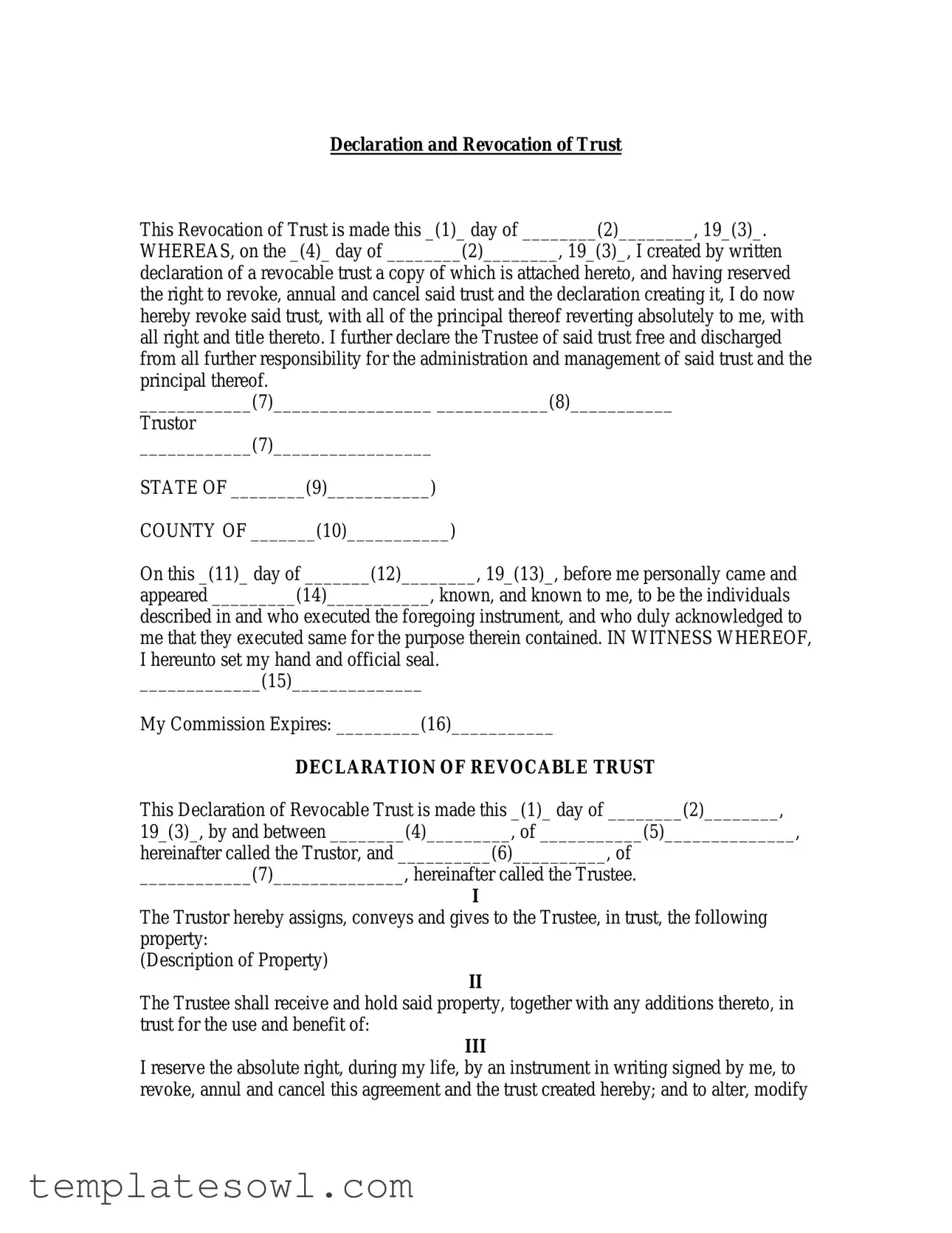Declaration and Revocation of Trust
This Revocation of Trust is made this _(1)_ day of ________(2)________, 19_(3)_.
WHEREAS, on the _(4)_ day of ________(2)________, 19_(3)_, I created by written
declaration of a revocable trust a copy of which is attached hereto, and having reserved the right to revoke, annual and cancel said trust and the declaration creating it, I do now hereby revoke said trust, with all of the principal thereof reverting absolutely to me, with all right and title thereto. I further declare the Trustee of said trust free and discharged from all further responsibility for the administration and management of said trust and the principal thereof.
____________(7)_________________ ____________(8)___________
Trustor
____________(7)_________________
STATE OF ________(9)___________)
COUNTY OF _______(10)___________)
On this _(11)_ day of _______(12)________, 19_(13)_, before me personally came and
appeared _________(14)___________, known, and known to me, to be the individuals
described in and who executed the foregoing instrument, and who duly acknowledged to me that they executed same for the purpose therein contained. IN WITNESS WHEREOF, I hereunto set my hand and official seal.
_____________(15)______________
My Commission Expires: _________(16)___________
DECLARATION OF REVOCABLE TRUST
This Declaration of Revocable Trust is made this _(1)_ day of ________(2)________,
19_(3)_, by and between ________(4)_________, of ___________(5)______________,
hereinafter called the Trustor, and __________(6)__________, of
____________(7)______________, hereinafter called the Trustee.
I
The Trustor hereby assigns, conveys and gives to the Trustee, in trust, the following property:
(Description of Property)
II
The Trustee shall receive and hold said property, together with any additions thereto, in trust for the use and benefit of:
III
I reserve the absolute right, during my life, by an instrument in writing signed by me, to revoke, annul and cancel this agreement and the trust created hereby; and to alter, modify
or amend this trust in any and all aspects; and to withdraw at any time, and from time to time, any and all of the aforesaid property; and to add thereto at any time, and from time to time, such additional property as I may determine.
IV
This agreement and the trust created hereby shall be administered, managed, governed and regulated in all respects according to applicable statutes of the State of
______(8)______.
V
The Trustee, in addition to all other powers granted by this agreement and by law, shall have the following additional powers with respect to the trust, to be exercised from time to time at the Trustee's discretion:
Management of the Trust
To invest and reinvest, lease, rent, mortgage, insure, repair, improve or sell any of the real and personal property of the trust as he may deem advisable.
Business Interests
To sell or otherwise liquidate, or to continue to operate at his discretion, any corporation, partnership or other business interest which may be received by the trust.
Mortgages, Pledges and Deeds of Trust
To enforce any and all mortgages, pledges and deeds of trust held by the trust and to purchase at any sale thereunder any such real estate or personal property subject to any mortgage, pledge or deed of trust.
Litigation
To initiate or defend, at his discretion, any litigation affecting the trust.
Attorneys, Advisors and Agents
To employ and to pay from the trust reasonable compensation to such attorneys, accountants, brokers, and investment, tax and other advisors as he shall deem advisable.
Adjustment of Claims
To submit to arbitration, to compromise or to release or otherwise adjust, with or without compensation, any and all claims affecting the trust estate.
VI
No bond for the faithful performance of duties shall be required of any Trustee appointed under this agreement.
VII
The Trustee shall receive reasonable compensation for the services performed by him, but such compensation shall not exceed the amount customarily received by corporate fiduciaries in the area for like services.
VIII
No Trustee of the trust created by this agreement shall at any time be held liable for any action or default of himself, or of his agent, or of any other person in connection with the administration and management of this trust unless caused by his own gross negligence or by commission of a willful act of breach of trust.
IX
The Trustee, by joining in the execution of this agreement, hereby signifies his acceptance of this trust.
X
The Trustee shall have sole authority to determine what shall be defined as income and what shall be defined as principal of the trust established by this agreement, and to determine which costs, taxes and other expenses shall be paid out of income and which shall be paid out of principal.
XI
In the event that any portion of this agreement or the trust created hereby shall be held illegal, invalid or otherwise inoperative, it is my intention that all of the other provisions hereof shall continue to be fully effective and operative insofar as is possible and reasonable.
IN WITNESS WHEREOF, the parties hereto have executed this agreement the day and year first above written.
____________(9)_________________ ____________(10)_______________
Trustor
____________(9)_________________
____________(9)_________________ ____________(11)_______________
Trustee
____________(9)_________________
I, the undersigned spouse of the above-described Trustor, do hereby waive and relinquish any and all claim to whatever community-property rights I may have in the hereinabove- described property and do give and grant my assent to the trust and to the incorporation therein of said property.
____________(9)_________________ ____________(12)_______________
Legal Spouse of Trustor
____________(9)_________________
STATE OF ________(13)___________)
COUNTY OF _______(14)___________)
On this _(15)_ day of _______(16)________, 19_(17)_, before me personally came and
appeared _________(18)___________ and _________(19)___________, known, and
known to me, to be the individuals described in and who executed the foregoing instrument, and who duly acknowledged to me that they executed same for the purpose therein contained.
IN WITNESS WHEREOF, I hereunto set my hand and official seal.
_____________(20)______________
My Commission Expires: _________(21)___________
